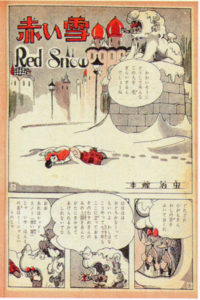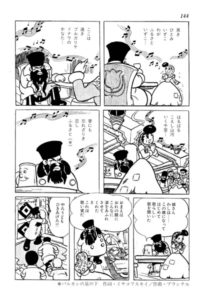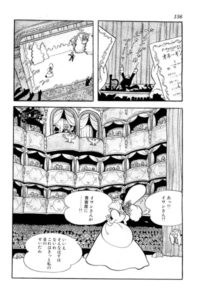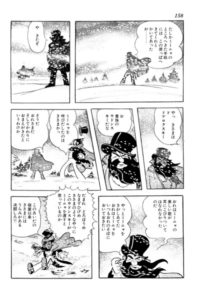Red Snow (Manga)
Also known as 赤い雪 (Akai Yuki)

| English Title: | Red Snow |
| In English? | No |
| Japanese Title: | 赤い雪 [Akai Yuki] |
| Type: | Ongoing Serial |
| Original run: | 1955/01 – 1955/05 |
| Published by: | Girl Friend [少女の友] |
| Volumes: | <1 (MT-060) |
Originally serialized from January and May, 1955 in the pages of the girl’s monthly, Girl Friend, Tezuka’s Red Snow (1955) is one of his lesser-known shojo adventure tales.
What it’s about
In the mid-19th century, When a baby is born during a “red” snowstorm in Imperial Russia the superstitious townspeople are panicked by the bad omen. Afraid that the girl will grow up to become a witch, they demand the parents cast the baby into the river. However at the last minute, the quick thinking of “Ivan the Idiot” – the local church belltower boy diverts the townspeople’s attention to the cracked church bell as being the cause of the ominous blood red snow and the baby is saved.

Red Snow’s song warms a bandit’s heart
As time passes, the baby grows into a lovely young girl named Minya. However, despite being saved from certain death, “Red Snow” as she’s known to the townspeople is treated as a witch – disowned and blamed for the family’s hardship even by her own father. Only Minya’s ailing mother shows her any love, but when she dies, Minya is left effectively homeless and penniless. However, once again it’s Ivan to the rescue as he convinces Minya to run away together.
Of course, soon the romantic notions of a carefree life are shattered, as the pair are chased by hungry wolves and then locked out of a local inn and left to freeze to death. As unluck would have it though, the inn is beset by the feared bandit, Homebrewsky and it is only Minya’s angelic singing that saves the inn’s patrons from the bandit’s wrath. Minya’s voice also catches the attention of an aristocrat named Nikolai Ramentov Udonsky and he insists that Minya (and Ivan) join him as his houseguests.

Singing before the emissary of the Tsar
Before long, Udonsky presents Minya to the famed Russian composer, Pyotr Ilyich Tchaikovsky and although he’s incredulous at first, after hearing her voice he immediately is inspired to write music for her. As Minya’s fame grows, so does Udonsky’s desire and he soon begins pressuring her into marriage. When she receives a love letter from a secret admirer, Udonsky sets out to confront his rival, only to discover himself face-to-face with the fearsome Homebrewsky.
The bandit makes quick work of Udonsky and kidnaps Minya for his own. However, Ivan comes to Minya’s rescue for a third time and Homebrewsky is defeated. In the aftermath, Ivan is revealed as a secret prince of the Romanov family who was sent to the church in hiding. The pair are married as red snows once again falls – this time as a good omen sent from her mother in heaven.

A showdown in the snow
What you should know
Red Snow (1955) first appeared as a serial in the shojo monthly Girl Friend – a magazine that began in 1908 and ran until 1955, making Tezuka’s feature one of its last to be published. It was a perfect home for the story to appear as the magazine catered to a then “modern” readership and liberally promoted both Takarazuka and foreign movie stars.
Although it is much less well-known than some of Tezuka’s other shojo manga from the same period, notably Princess Knight [Shojo Club] (1953-56), it greatly inspired female manga artist Miyako Maki (half of Japan’s “manga power couple” with her husband, Leiji Matsumoto). After reading Red Snow (1955) she reportedly spent seven months crafting Hahakoi Waltz (母恋いワルツ), which was published as a book in 1957, and marks her professional debut.
Red Snow (1955) is reportedly, according to literary critic Koichi Kato, heavily influenced by the Soviet animation ‘The Snow Queen’ – although it’s unclear how that’s possible because Red Snow (1955) came out in 1955 and The Snow Queen seems to have been released in 1957. To be confirmed. Both could be inspired by the same source material though, the Hans Christian Andersen tale.
Finally, sharp-eyed readers may notice Tezuka’s well-known oddball sense of humour on display in Red Snow (1955) – especially in the case of the names of a few of the main characters. Although “Ramentov Udonsky” is relatively easy for English-speakers to pick up on the “noodle-like” origins of the name, it’s worth pointing out that the bandit Homebrewsky’s original name in Japanese is “Doburokusky” – with doburoku being a type of cloudy, homemade sake.


